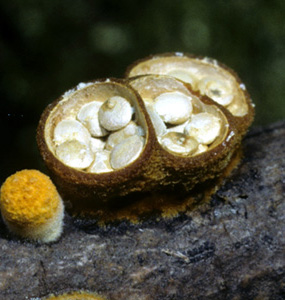Crucibulum laeve

Image Courtesy of Henry H. Mashburn
| Click to Enlarge |
| Click For Image Gallery |
|
Group of Fungi: Bird's Nest Fungi Family: Agaricaceae Latin Name: Crucibulum laeve (Huds.) Kambly Common Name: White-egg Bird's Nest Fungus Description: Globose to short-cylindrical (but tapering towards the base) structure when young but becoming cup-shaped when a covering (lid) over the upper surface disintegrates to reveal numerous egg packets (the "eggs") in the cup ("nest"), 1/4–3/8 in (0.5–1 cm) high and up to 3/8 in (1 cm) across, surface of lid ochraceous, velvety, sides of the cup roughened to finely wrinkled, buff-brown, inner surface of cup smooth, pale grey to light-brown; eggs (peridioles) 1/32–1/16 in (1–1.5 mm) in diameter, flattened, white to pallid, each egg connected to the inner surface of the cup by thin cord (funiculus); stalk lacking; spores hyaline in mass. Biological Role: Decomposer of wood and wood debris. Habitat: On twigs, dead branches, fallen logs and various types of organic debris; often occurring in small to large clusters. Geographical Distribution: Widely distributed throughout North America. Comments: This is the most common bird's nest fungus and the only one with white eggs. The fruiting bodies are rather tough and resistant to decay, so it is possible to find "empty nests" at any time of the year. |
| Go Back |